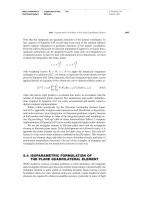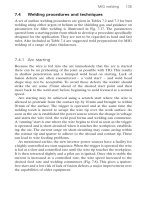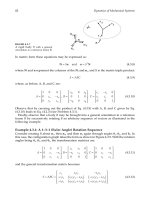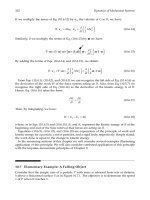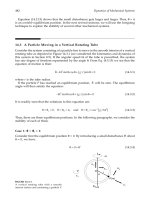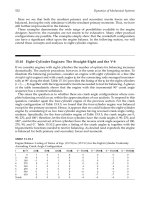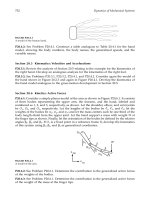Maintenance of Petroleum Systems B Episode 8 ppt
Bạn đang xem bản rút gọn của tài liệu. Xem và tải ngay bản đầy đủ của tài liệu tại đây (82.61 KB, 15 trang )
UFC 3-460-03
21 JANUARY 2003
104
Electrical components 10.3.20 Quarterly
Hydrant adapters 10.3.21 Semi-annually
Auto tank gauge 10.3.22 Annually
Strainer 10.3.23 As required
Piping
Pressure test 10.3.6.1 Annually
Hydrostatic test 10.3.6.2 Every 5 years
Exposed piping 10.3.6.3
Corrosion control 10.3.6.3.1 Semi-annually
Identification 10.3.6.3.2 Quarterly
Pumps
General maintenance 10.3.7.1 Quarterly
Lubrication 10.3.7.2 Quarterly or per manufacturer
Product recovery 10.3.7.3 Quarterly
Storage Tanks
Vacuum/pressure vent 10.3.4 Semi-annually
Dikes 10.3.5 Annually
Aboveground 10.3.3.1
Visual inspection 10.3.3.1.1 Monthly
API 653 10.3.3.1.2 Every 10 years
Floating roof/pan 10.3.3.2
Seals and pan 10.3.3.2.1 Monthly
Roof drain 10.3.3.2.2 Monthly
Roof drain (antifreeze) 10.3.3.2.4 As required
Cleaning/inspection 10.3.3.3
Without F/S and coating 10.3.3.3.1 Every 4 years
With F/S or coating 10.3.3.3.2 Every 6 years
With F/S and coating 10.3.3.3.3 Every 8 years
10.3.1. System Areas. Large grass-covered areas around fuel systems will be mowed by BCE
personnel or by service contract. Consult the Maintenance Engineering shop for questions
concerning performance of this task by contract.
FREQUENCY: As required.
10.3.2. Hoses.
UFC 3-460-03
21 JANUARY 2003
105
10.3.2.1. Offloading Hoses. For truck or tank car offloading areas, use 101-millimeter (4-inch)
lightweight, reinforced, vacuum-rated offloading hoses (see MIL-HDBK-1022A). Test per the
manufacturer’s instructions.
FREQUENCY: Prior to initial installation and as determined by the LFM supervisor and
local environmental requirements.
10.3.2.2. Issue Hoses. Truck fill stand, marine off-loading, and aircraft refueling hoses must
meet the standards of API 1529. Hydrostatically test to one and one-half times the dead head
(shutoff head) pressure of the system, not to exceed the maximum working pressure of the hose.
NOTE: Hydrostatic hose testing for real property installed equipment (RPIE) is a joint
operator/LFM responsibility, yet primary responsibility lies with the LFM shop foremen. The
LFM shop maintains hydrostatic test records and performs the test. Mutual arrangements for
hose testing by the refueling maintenance (RFM) shop is authorized and encouraged where
possible. Ground product hoses with working pressures less than 20 psi do not require pressure
testing.
FREQUENCY: Prior to initial installation and as determined by the LFM shop foreman,
local environmental requirements, and manufacturer’s recommendation. When an API
1529 hose is delivered with a hydrostatic certification from the manufacturer, initial testing
is not required.
10.3.3. Storage Tanks.
10.3.3.1. Aboveground Field-Constructed Tanks.
10.3.3.1.1 Visual Inspection. Visually check the exterior of each tank for leaks, corrosion, or
irregularities such as tilting, settling, or out-of-roundness. Give special attention to seams
and anchor bolts. Maintain a waterproof seal at the tank chime-ring wall foundation
interface. Retain records in the LFM shop for five years. Scrape, clean, and repaint rusted or
corroded areas.
FREQUENCY: Monthly.
10.3.3.1.2. Out-of-Service API 653 Inspection. Use nondestructive techniques to inspect all
metallic surfaces, including the floor.
FREQUENCY: Every 10 years.
10.3.3.2. Floating Roof or Pan.
10.3.3.2.1. Clean and check perimeter tank seals; check centering of roof or pan. The
performance of this task may require a confined space entry.
FREQUENCY: Monthly.
10.3.3.2.2. For open-top floating-roof tanks, ensure the center primary roof drain system is
water-free, the drip-tight plug is placed in the roof drain opening, and the roof drain valve is
closed. The drain valve is kept in the closed position except after each rain or snowfall when
it will be opened just long enough to drain the roofline.
FREQUENCY: Monthly.
10.3.3.2.3. The LFM shop foreman is responsible for training FMF personnel on procedures
for draining floating-roofs and interior dike basins. Once trained, FMF retains responsibility
for draining roof drains and interior dike basins.
10.3.3.2.4. At locations where freezing conditions are encountered, the LFM shop will fill
the floating-roof tank drain line with antifreeze or deicing fluid. Periodically test the
UFC 3-460-03
21 JANUARY 2003
106
antifreeze or deicing fluid for proper protection and record results. The roof drain valve must
be secured and will have a sign attached to it stating:
CAUTION - WINTERIZED - DO NOT DRAIN
FREQUENCY: As Required.
10.3.3.3. Tank Inspection/Cleaning Requirements (Aviation Products). Operating and bulk
storage tanks have identical inspection/cleaning frequencies. Follow governing environmental
regulations if more stringent. Complete AF Form 172 and submit it to the MAJCOM fuels
facility engineer.
10.3.3.3.1. Tanks without an inlet F/S, micronic filter on the inlet, or internal coating.
FREQUENCY: Every 4 years.
10.3.3.3.2. Tanks with F/S or micronic filter on the inlet or internal coating.
FREQUENCY: Every 6 years.
10.3.3.3.3. Tanks with F/S or micronic filter on the inlet and
internal coating, or built to the
standard design.
FREQUENCY: Every 8 years. This may be extended to coincide with the API 653 out-
of-service inspection every 10 years after the first inspection is completed.
10.3.4. Tank Vacuum and Pressure Vents. Inspect, clean, and repair. Where applicable, inspect
antifreeze levels in the spring and fall. A mixture of equal parts of water and antifreeze will be used.
FREQUENCY: Semi-Annually.
10.3.5. Dikes.
10.3.5.1. Earthen.
10.3.5.1.1. Inspect for signs of erosion and vegetation.
FREQUENCY: Annually.
10.3.5.1.2. Use fireproof chemicals for sterilization of dikes and basins to prevent growth of
vegetation. Work should be done by BCE entomology personnel or by contract.
FREQUENCY: As required.
10.3.5.2. Concrete, Asphalt, or Cement Brick. Inspect condition and repair as required.
FREQUENCY: Annually.
10.3.6. Piping.
10.3.6.1. Pressure Test. Pressurize all on-base fuel piping systems using existing system pumps.
When conducting the test, follow the guidance outlined in paragraph 2.3.3.1.
FREQUENCY: Annually.
10.3.6.2. Hydrostatic Test. Perform a hydrostatic pressure test on all underground fuel transfer
lines. Product is normally the test media. Details for conducting the test are provided in
paragraph 2.3.3.2. Consult your fuels facility engineer for guidance on completing this
requirement. The fuels facility engineer is the approving authority for all waivers of this
requirement. Dual pressure temperature compensating pressure test methods may be considered
with approval from the MAJCOM fuels engineer. This method may allow the test to be
conducted faster with fewer blind flanges than the traditional hydrostatic pressure test described
in paragraph 2.3.3.2.
FREQUENCY: Every 5 years.
10.3.6.3. Exposed Piping.
UFC 3-460-03
21 JANUARY 2003
107
10.3.6.3.1. Check all exposed piping, valves, and associated equipment for corrosion.
Prepare the surface and repaint as necessary.
FREQUENCY: Semi-Annually.
10.3.6.3.2. Piping identification must conform to MIL-STD-161. Repaint as necessary.
FREQUENCY: Quarterly.
10.3.7. Pumps.
10.3.7.1. Check for unusual noise, vibration, over-heating, leaks, and oil level.
FREQUENCY: Quarterly.
10.3.7.2. Lubricate pumps and motors as recommended by the manufacturer.
NOTE: Excessively greased bearings can cause over-heating.
FREQUENCY: Quarterly, or as recommended by the manufacturer.
10.3.7.3. Product Recovery Tank Pump. The pump should start when the liquid level reaches
70% of the tank’s total capacity, and shut off when the level is pumped down to 20%.
FREQUENCY: Quarterly.
10.3.8. Manual Valves.
10.3.8.1. Lubricated Plug. Inspect all lubricated plug valves for ease of operation. If lubrication
is needed due to difficult operation, replace the valves immediately with non-lubricated valves.
All lubricated plug valves must be scheduled for replacement.
FREQUENCY: Quarterly.
10.3.8.2. Gate. Lubricate and operate to prevent seizing. Adjust/replace packing as needed.
FREQUENCY: Quarterly.
10.3.8.3. Non-Lubricated Plug Valves. Inspect for ease of operation. Adjust packing and
maintain operators per manufacturer’s specifications.
FREQUENCY: Quarterly.
10.3.8.4. Ball. Inspect for ease of operation and lubricate operators.
FREQUENCY: Quarterly.
10.3.9. Filter Separator (F/S).
10.3.9.1. F/S Element. At the last point of filtration in the fixed system, replace elements at 15
psi DP, or every three years, whichever comes first. Replace elements at all other locations at 20
psi DP, or every three years, whichever comes first. During element replacement, clean the
interior surfaces of the F/S vessel and second-stage element(s) (see paragraph 3.3 for detailed
instructions). Use API edition 4 or 5 elements. Funding will be provided by DESC.
10.3.9.2. Determining DP. DP is measured at the rated flow of the vessel (e.g., 20 psi at 2271
liters per minute [600 gallons per minute]). If two 2271-liter-per-minute pumps discharge
through four F/Ss, then a DP of 10 psi at 1135 liters per minute (300 gallons per minute) would
be equal to 20 psi at 2271 liters per minute. Before changing out elements, verify the pressure
drop at 2271 liters per minute by isolating the F/S so it receives a flow of 2271 liters per minute
and measure the DP. This is particularly critical with Type III systems where fuel from a
varying number of pumps flows through multiple F/Ss. In older systems where a 4542-liter-per-
minute (1200-gallon-per-minute) filter vessel is dedicated to a 2271-liter-per-minute pump,
change out the elements as if it were a 2271-liter-per-minute vessel. If the DP across a vessel
suddenly drops 3 psi or more at the same flow rate, check the vessel for a damaged element.
UFC 3-460-03
21 JANUARY 2003
108
NOTE: Before placing the F/S back in service, contact the FMF to ensure flushing and sampling
is accomplished (see T.O. 42B-1-1, Quality Control of Fuels and Lubricants).
10.3.10. Micronic Filter. Determine filter element replacement by manufacturer data, or after
757,082 liters (200,000 gallons) of fuel have passed through the elements, whichever occurs first.
The MAJCOM fuels engineer may extend the filter replacement based on DP for high through-put
installations.
10.3.11. Surge Suppressors. Check pressure settings and adjust in accordance with the
manufacturer’s specifications.
FREQUENCY: Quarterly.
10.3.12. Testing and Calibrating Meters. Component wear and accumulation of solids make
periodic calibration necessary.
10.3.12.1. Certified master meters are used for meter calibration by connecting hoses from the
hydrant outlet or fill stand to the master meter, and from the master meter to a tank truck or
servicing vehicle. Calibrate master meters annually.
10.3.12.2. Test meters at a predetermined flow rate and at calibration settings between 20% and
100% capacity. Meters are satisfactory when the meter error in the normal flow direction is
within ±0.2% of actual quantity delivered (e.g., ±1.2 gallons for a 600-gallon test ). Calibrate
service station meters to within ±0.2%. Adjust meters according to manufacturer’s
recommendations. Use stencils or embossing tape to permanently mark the installed meters.
FREQUENCY: Annually.
10.3.12.3. Meters with installed drain plugs will be drained of water and sediment by FMF
personnel. The LFM shop foreman will ensure drainable meters have the proper connections
installed.
FREQUENCY: Weekly.
10.3.13. Signs and Markings. Check signs and markings for adequacy and readability. See AFOSH
Std 91-38, Section 3.2, for descriptions of sign locations, and MIL-STD-161F2, Identification
Methods for Bulk Petroleum Products Systems Including Hydrocarbon Missile Fuels, for marking
requirements.
FREQUENCY: Annually.
10.3.14. Pressure Relief. Check system pressure relief to ensure proper operation. Test and/or
adjust the pressure relief valve 10% above system deadhead pressure, not to exceed 275 psi. Repeat
the test, if applicable, a minimum of three times to ensure proper operation. Not all pressure relief
valves are set at 10% above the maximum operating pressure. Thermal relief valves must be set to
allow cascading of pressure back to the storage tank. In this case use set points specified in
construction documentation.
FREQUENCY: Annually.
10.3.15. Service Station Dispensers. Check operation, belt alignment, strainer, linkage operations,
hoses, meter calibration, relief assembly, and automatic nozzle shutoff functions.
FREQUENCY: Quarterly.
10.3.16. Direct-Reading/DP Gauges. Calibrate according to the manufacturer’s specifications.
NOTE: Piston-type DP gauges require calibration only at USAFE bases. Calibration procedures are
in NATO STANAG 3583, Standards of Accuracy for Different Press Gauges for Aviation Fuel
Filters and Filter/Separators.
UFC 3-460-03
21 JANUARY 2003
109
FREQUENCY: Annually.
10.3.17. Differential Pressure Transmitter (DPT) and Pressure Indicating Transmitter (PIT).
Calibrate mechanically and electrically with test equipment and adjust if applicable. Calibrate in
accordance with manufacturer’s specifications.
FREQUENCY: Semi-annually.
10.3.18. Cathodic Protection Systems. Cathodic protection is maintained by the base cathodic
protection technician or by service contract. The LFM shop foreman will ensure the cathodic
protection systems on the POL system are maintained by the base cathodic protection technician in
accordance with UFC 3-570-06, Operation and Maintenance: Cathodic Protection Systems, and AFI
32-1054. Close interval (soil-to-structure potential) piping surveys should be conducted initially
within 30 days of installation and every five years thereafter.
FREQUENCY: As required.
10.3.19. Tank Entry, Confined Space Entry, and other Personal Protective Equipment (PPE).
Inspect for serviceability, cleanliness, and deterioration. See Chapter 11 for detailed instructions.
Service equipment in accordance with manufacturer’s specifications.
FREQUENCY: Annually, or before use.
10.3.20. Electrical Equipment. Verify proper operation of all electrical equipment associated with
the operation of the installation’s POL infrastructure. Identify necessary repairs to the zone or
electrical section with responsibility for the area. Typical inspection items include, but are not
limited to:
Ground conductors
Ground connections
Starters and Contactors
Circuit breakers
Area lighting
Grounding cables
Disconnect switches
Exposed wiring
Emergency switches
Flow switches
FREQUENCY: Quarterly.
10.3.21. Hydrant Adapters. Check for leaks and damage.
FREQUENCY: Semi-Annually.
10.3.22. Automatic Tank Gauges (ATG). Calibrate with test equipment and adjust as required.
Ensure the gauge is free of moisture and debris. Many ATGs are maintained by contract under the
Petrol Ram Contract. Contact the AFPET office for more information (see paragraph 6.3.2.7).
FREQUENCY: Annually.
10.3.23. Strainer. Inspecting and cleaning system strainers is the responsibility of FMF personnel.
The LFM shop will supply guidance and/or replacement parts as required.
FREQUENCY: As required.
UFC 3-460-03
21 JANUARY 2003
110
10.3.24. Automatic Control Valves. Following is a list of valves by type of system and valve
function. The numbers shown after each valve are Cla-Val designations. Actions and frequencies
required below are not limited to Cla-Val, but apply to all manufacturers’ valves having the same
function. Any automatic valves not listed will have a Quarterly RWP frequency. NOTE: The
amount of maintenance required on the listed automatic valves will vary with each inspection. The
intent of the inspection is to determine the valves proper operation and performance. If it is
determined that the valve is operating correctly, pilot control adjustment and/or main valve
calibration is not required.
10.3.24.1. Type I Panero System.
10.3.24.1.1. High Level Shut-Off Valve (HLSO) (124AF). When the tank is being filled,
check for proper operation of the HLSO valve. Check high-level alarms with high-level
control valves. Set valve to activate when the fuel level is approximately 11 inches from the
top of the tank. this should be no more than 95% full.
FREQUENCY: Semi-annually.
10.3.24.1.2. Non-Surge/Check Valve (81AF). Check opening speed (approximately 20
seconds) and check valve function.
FREQUENCY: Semi-annually.
10.3.24.1.3. Fuel Shut-Off Control Valve (FSCV) (40AF-2A).
10.3.24.1.3.1. Flow Rate. Check flow rate. Flow rate is determined by F/S vessel gallon-
per-minute rating, or element flow rate, whichever is less.
FREQUENCY: Semi-annually.
10.3.24.1.3.2. Water Shut-off. Test FSCV, either by engaging the flanged float test
button or lever while flowing fuel through the F/S, or by injecting water until the ball
float is in the “up” position. Ensure the FSCV shuts off when the ball float is in the “up”
position. When the mission mandates the use of water drain valves, check the drain valve
operation also. Drain water immediately upon completing the test.
CAUTION: When performing this test, only flow the minimum amount of fuel through
the F/S to prevent system pressure spikes. Check FSCV on 50-gallon-per-minute product
recovery tank pumps. Newer Type III systems have FSCVs with emergency shutdown
capability.
FREQUENCY: When elements are changed.
10.3.24.1.4. Fueling/Defueling Control Valve (302AF). Check both refueling and defueling
control valve features. Check pressure-reducing control, pressure-relief control, opening
rate, excess flow shutoff, defuel pressure-relief control, and solenoid operation. See Chapter
3 for pressure setting procedures.
FREQUENCY: Quarterly.
10.3.24.2. Type II Pritchard System.
10.3.24.2.1. Refueling Control Valve (90AF-8). Check pressure-reducing control, pressure-
relief control, opening rate, excess flow shutoff, and solenoid operation. See Chapter 4 for
pressure setting procedures. For excess flow control, see Attachment 3.
FREQUENCY: Quarterly.
10.3.24.2.2. Defuel Control Valve (134AF). Check solenoid operation.
FREQUENCY: Quarterly.
UFC 3-460-03
21 JANUARY 2003
111
10.3.24.2.3. Rate-of-Flow Defuel Valve (41AF). Check rate of flow control and check valve
function. Set flow rate at 200 gallons per minute.
FREQUENCY: Quarterly.
10.3.24.2.4. Pressure Relief Valve (50AF-2). Check pressure-relief function. The typical
pressure setting is 10 psi above normal inlet pressure for the 90AF-8.
FREQUENCY: Semi-annually.
10.3.24.2.5. High-Level Shut-Off Valve (129AF). When the tank is being filled, check for
proper operation of the high-level control valve. Check high-level alarms with high-level
control valves. Set shut-off level at 11 inches from the top of the tank or 95% full, whichever
is less.
FREQUENCY: Semi-annually.
10.3.24.2.6. Non-Surge Check Valve (81AF-8). Check opening speed (about 20 seconds)
and check valve function.
FREQUENCY: Semi-annually.
10.3.24.3. Type II Modified Pritchard System.
10.3.24.3.1. Combination Rate-of-Flow, Solenoid Shutoff, and Check Valve (41AF-10).
Check rate-of-flow control, check-valve function, and solenoid functions. Set at 200 gallons
per minute.
FREQUENCY: Quarterly.
10.3.24.3.2. Combination Dual Pressure Relief, Solenoid Shutoff, and Check Valve (51AF-
4). Check low- and high-pressure relief functions, check-valve function, solenoid functions,
and closing speed control. See Chapter 5 for pressure setting procedures.
FREQUENCY: Quarterly.
10.3.24.4. Type III Constant-Pressure Hydrant Fueling System (Phillips System).
10.3.24.4.1. High-Level Shut-Off Valve (413AF-5A). When the tank is being filled, check
for proper operation of the high-level control valve.
CAUTION: When testing, use the minimum flow rate necessary.
FREQUENCY: Semi-annually.
10.3.24.4.2. Rate of Flow, Non-Surge Check Valve (41AF-1A). Check opening speed, flow
rate, and check-valve function. The typical opening speed is approximately 20 seconds. The
typical flow rate is 650 gallons per minute.
FREQUENCY: Semi-annually.
10.3.24.4.3. Fuel Shut-off Control Valve (41AF-2C). Check rate of flow, check-valve
function, and water shutoff features. The typical setting is 600 gallons per minute.
FREQUENCY: Semi-annually.
10.3.24.4.4. Back Pressure Control Valve (58AF-9). Check pressure control, closing rate
speed, solenoid operation, and check-valve function. The typical setting is 100 psi at the
inlet of the furthest hydrant outlet, and set closing speed control as fast as possible while still
maintaining smooth operation. NOTE: This valve typically uses a restrictor to aid in
opening.
FREQUENCY: Quarterly.
10.3.24.4.5. Defuel/Flush Valve (58AF-9-1). Check pressure relief, check-valve function,
solenoid operation, and opening and closing speed controls. The typical pressure relief
UFC 3-460-03
21 JANUARY 2003
112
setpoint is 80 psi. Set the opening and closing speed control as fast as possible while still
maintaining smooth operation.
FREQUENCY: Quarterly.
10.3.24.4.6. Pressure Control Valve (58AF-3). Check pressure control, opening and closing
rates, and solenoid operation. The typical setpoint is 75 psi. The typical opening and closing
speed is 3 seconds.
FREQUENCY: Quarterly.
10.3.24.4.7. Hydrant Control Valve (362AF-8). Check pressure-reducing control, pressure-
relief control, opening speed, and deadman operation. NOTE: HCV is also located at the
HSV check-out stand.
FREQUENCY: Quarterly.
10.3.24.4.8. Emergency Shut-Off Valve (136AF-9B). Check solenoid operation, DP
control, and quick-closing feature. Verify valve closes within 10 seconds. Solenoids are
energized, except during power failures or when the ESO switch is activated. The typical
setting for differential control is 7 psi.
FREQUENCY: Quarterly.
10.3.24.4.9. Product Recovery Tank Overfill Valve (2129AF). Check the thermal-relief
feature, overfill-protection operation, and ensure the pressure reservoir tank holds pressure.
The typical setting for thermal relief is 200 psi. The OV must be set to close and sound an
alarm in the control room when the tank is 80% full. Ensure the pressure reservoir tank holds
the pump deadhead pressure when the pump is deactivated. NOTE: When the float in the
tank rises and the OV changes position, the pressure in the pressure reservoir tank will
decrease.
FREQUENCY: Semi-annually.
10.3.24.5. Type IV Hot Pit Refueling System.
10.3.24.5.1. High-Level Shut-Off Valve (129AF-3A). When the tank is being filled, check
for proper operation of the high-level control valve. This valve uses a fail-safe closed pilot
system. This means that if the control line ruptures, the main valve will close.
CAUTION: When testing, use the minimum flow rate necessary.
FREQUENCY: Semi-annually.
10.3.24.5.2. Defuel/Flush Valve (58AF-9-1). Check pressure relief, check-valve function,
solenoid operation, and opening and closing speed controls. The typical pressure relief
setpoint is 100 psi. Set the opening and closing speed control as fast as possible while still
maintaining smooth operation.
FREQUENCY: Quarterly.
10.3.24.5.3. Pantograph Pressure Control Valve (PPCV) (58E-47). Check pressure control,
opening and closing rates, and solenoid operation. The typical setpoint is 75 psi. The typical
opening and closing speed is 3 seconds.
FREQUENCY: Quarterly.
10.3.24.5.4. Hydrant Control Valve (362AF-7). Check pressure-reducing control, pressure-
relief control, opening speed, and deadman operation. The typical setting for pressure-
reducing control is 45 psi. The pressure-relief control must close within 5 seconds when
system pressure reaches 50 psi. The typical opening speed is 20 seconds; however, to
dampen the nozzle pressure wave, opening speed may be retarded. When the deadman is
UFC 3-460-03
21 JANUARY 2003
113
released, the deadman must close the valve within 5 seconds. NOTE: This valve is
connected to the pantograph system and is hydraulically operated.
FREQUENCY: Quarterly.
10.3.24.5.5. Emergency Shut-Off Valve (136AF-9B). Check solenoid operation, DP
control, and quick-closing feature. Verify valve closes within 10 seconds. Solenoids are
energized except during power failures or when the ESO switch is activated. The typical
setting for the differential control is approximately 7 psi.
FREQUENCY: Quarterly.
10.3.24.5.6. Flush Valve (136AF-5A). Check solenoid operation and quick-closing feature.
Solenoid is de-energized when the system is placed in pantograph flush.
FREQUENCY: Quarterly.
UFC 3-460-03
21 JANUARY 2003
114
Chapter 11
ENTRY FOR INSPECTING, CLEANING, REPAIRING, AND COATING LIQUID
PETROLEUM TANKS
11.1. Introduction. This chapter provides minimum standards for safe entry, inspection, cleaning,
repairing, and coating of liquid petroleum tanks. The names formally used to describe LFM tank-
cleaning positions (tank cleaning supervisor, worker, manhole observer, fresh air blower monitor, safety
[emergency] person) have been changed to align the LFM career field with the Air Force Confined
Space Entry Program (CSEP). The new names: tank entry supervisor (TES); entrant; attendant;
regulator monitor; and organizational rescue team (standby rescue personnel), respectively.
11.2. Standards.
11.2.1. For all tank cleaning and related functions, follow the guidance in API Std 2015, Safe Entry
and Cleaning of Petroleum Storage Tanks, Planning and Managing Tank Entry from
Decommissioning through Recommissioning. API Std 2015 contains a comprehensive planning
checklist in Appendix E. The rest of the paragraphs in this chapter tailor guidance in the API
publication to the LFM requirement.
11.2.2. The following AFOSH standards are to be used in lieu of the OSHA standards covered in the
API publication:
11.2.2.1. AFOSH Std 91-25, Confined Spaces (49 CFR 1910.146, Permit-Required Confined
Spaces).
11.2.2.2. AFOSH Std 91-31, Personal Protective Equipment (PPE).
11.2.2.3. AFOSH Std 91-38, Hydrocarbon Fuels, General.
11.2.2.4. AFOSH Std 48-137, Respiratory Protection Program.
11.2.2.5. AFOSH Std 48-8, Controlling Exposure to Hazardous Materials.
11.2.2.6. AFOSH Std 91-5, Cutting and Brazing.
11.3. TES Certification Requirements. The TES is responsible for all aspects of tank entry and must
have an AF Form 483, Tank Cleaning Certificate of Competency card issued by the MAJCOM fuels
engineer. Certification will not exceed five years from the completion date of the Air Education and
Training Command (AETC) TES course. The MAJCOM fuels engineer may approve a one-year
waiver. Certificates are not transferable between MAJCOMs. Submit the following to the MAJCOM
fuels engineer for certification:
11.3.1. Certification of Training. Forward a copy of the AETC TES course completion certificate
(AF Form 1256, Certificate of Training). This course is mandatory for certification and must be
redone every five years. A one-year waiver may be approved by the MAJCOM fuels engineer to
allow for scheduling difficulties.
11.3.2. Tank Cleaning Experience. List at least two tanks cleaned, showing dates, size, location, and
tank-cleaning supervisor.
UFC 3-460-03
21 JANUARY 2003
115
11.3.3. Medical Evidence. Applicant is physically qualified to perform tank cleaning.
11.4. Tank Entry Personnel Requirements.
11.4.1. Medical Requirements. Prior to entry and or cleaning operations, each tank entrant (military
or civilian) must have proof of a current physical (AF Form 600, Treatment Record, or equivalent),
or an appropriate medical statement from the local medical facility stating the applicant is physically
qualified to perform tank cleaning. Medical statements are valid for one year. Provide an AF Form
2772, Certificate of Respirator Fit Test, or equivalent showing the individual has been fit-tested to
wear a respirator.
11.4.2. Health Effects. Colds, fatigue, overheating, or lowered physical resistance from any source
increases a person's susceptibility to hazards encountered in tank entry.
11.4.3. Psychological Effects. Anyone with a medically documented history of claustrophobia will
be disqualified from entering any tanks.
11.5. Confined Space Entry Requirements. AFOSH Std 91-25 contains requirements for practices
and procedures that provide protection for Air Force employees (military and civilian) who enter and
work within confined spaces. Information in AFOSH Std 91-25 is considered the Air Force’s minimum
safety, fire prevention, and occupational health requirements.
11.6. Tank Cleaning Crew.
11.6.1. Crew Members. The typical crew size for tank entry is five: TES; entrant; attendant;
regulator monitor (duties may be performed by the attendant if conditions allow); and organizational
rescue team (standby rescue personnel). Additionally, a pump or compressor operator may be
required. Individuals assigned these duties will not leave their positions until relieved by the TES.
Any deviation from the above must be coordinated with the MAJCOM fuels engineer.
11.6.2. TES. The TES, also referred to as the entry (on-site) supervisor, is responsible for all aspects
of tank entry and stays at the job site until all individuals have exited the tank. The TES only
transfers supervisory responsibility when he or she enters the tank. Before entry, the TES appoints an
equally qualified individual to run operations while he or she is in the tank.
11.6.2.1. The TES ensures all workers are properly trained on safe tank entry procedures, use of
protective equipment, and ways to egress the confined space.
11.6.2.2. The TES must review as-built drawings to become familiarized with tank components
and appurtenances.
11.6.2.3. Before starting any tank entry project, the TES briefs all members of the tank entry crew.
The briefing includes: duties of each member; hazards affecting the entry; component inspection
requirements; worker actions if there is an emergency; length of time each person will be in the
tank; effects of inhalation; other health and safety aspects inherent to the entry.
11.6.2.4. The TES must follow the confined space entry procedures outlined in
AFOSH Std 91-25, Paragraph 2.13. For additional information, use the planning checklist in
AFOSH Std 91-25, Appendix E, as a guide to develop a site-specific work plan.
UFC 3-460-03
21 JANUARY 2003
116
11.6.3. Entrant. The entrant is the individual trained, qualified, and authorized to enter the confined
space. Entrants must:
11.6.3.1. Fully understand all cleaning procedures, inspection requirements, safeguards, and
emergency egress and or rescue procedures associated with the entry.
11.6.3.2. Follow all safe work procedures required by the TES.
11.6.3.3. Notify the TES when hazards exist that have not been corrected.
11.6.3.4. Notify the TES if he or she is ill or on medication.
11.6.3.5. Immediately exit the tank when directed by any member of the tank cleaning crew or
when they recognize the warning signs of exposure to hazardous substances.
11.6.4. Attendant. The attendant stays outside the tank and monitors the entrants inside. The
attendant should maintain continuous communication with all authorized entrants, by voice, visual
observation, communications gear, or other equally effective means.
11.6.4.1. The attendant has the authority to order entrants out of the tank at the first sign of an
unexpected hazard.
11.6.4.2. The attendant must know the procedure and have the means to summon emergency
assistance if needed. They must stay at their post and not leave for any reason (except self-
preservation) unless replaced by an equally qualified individual.
11.6.4.3. The attendant continuously monitors the atmospheric levels while the entrants are inside
the tank.
11.6.5. Regulator Monitor. The regulator monitor is the individual that is responsible for ensuring an
uninterrupted supply of breathing air is provided to all workers in the tank. Self-contained breathing
apparatus (SCBA) systems must always be monitored while workers are inside the tank. If only
minimum manning is available, the attendant can double as the regulator monitor. This individual
must be able to see the gauges, hear the warning devices, and summon workers out of the tank if an
unacceptable condition arises. Also, the regulator monitor must:
11.6.5.1. Be fully trained on the operation of the air regulator, alarms, warning devices, and proper
setup of the air bottle or cascade system.
11.6.5.2. Ensure all equipment is in proper working order and has been thoroughly operationally
checked prior to workers entering the tank.
11.6.5.3. Notify the attendant or TES of any condition that could hinder the supply of air to
workers inside the tank.
11.6.5.4. Monitor air equipment and low-air warning devices until all workers exit the tank and
remove their masks.
11.6.6. Organizational Rescue Team. This team includes the TES, attendant, and at least one stand-
by rescue person for each individual inside the tank. . For aboveground storage tanks that are less
than 12 meters (40 feet) in diameter with two open manways, only one stand-by rescue person is
required for every two men in the tank. If two workers are inside the tank, then two rescue people
will be standing by equipped with the appropriate PPE. All rescue personnel must meet the training
requirements outlined in AFOSH Std 91-25, Paragraph 5.5, and the training requirements of the
entrant. Members of the organizational rescue team can be trained locally or in technical school in
the correct performance of their assigned duties. Also, members must be trained annually in CPR.
UFC 3-460-03
21 JANUARY 2003
117
CPR training will be documented on the individual’s AF Form 55, Employee Safety and Health
Record. The team should practice once per year.
11.7. Tank Entry Coordination. Before entering the tank, coordinate with the following:
11.7.1. Coordinate entry date with FMF. Before FMF lowers the fuel level, set the floating roof or
pan adjustable legs to the 1.8-meter (six-foot) level. Follow confined entry requirements and refer to
API Publication 2026, Safe Access/Egress Involving Floating Roofs of Storage Tanks in Petroleum
Service.
11.7.2. Notify Environmental Management (CEV) of scheduled operations to ensure adequate waste
disposal containers are available and disposal procedures are identified.
11.7.3. Upon coordination with FMF, request permission from the MAJCOM fuels engineer for tank
entry at least fifteen workdays before the desired entry date. Include the dates of work, facility/tank
number, size, type of fuel, purpose of entry, and name of the TES.
11.7.4. Notify base Ground Safety (SEG), Fire Protection (CEF), and BEE during this fifteen-day
period to ensure adequate procedures are in place for safety, fire prevention, and rescue during the
operation.
11.8. Tank Entry Preparation.
11.8.1. Ensure the entire area next to the work site is secured and cleared of all non-essential
personnel. If the area cannot be isolated by using existing fencing, use rope to establish a perimeter
at least 15.2 meters (50 feet) from the tank openings. Provide warning signs (e.g., “DO NOT ENTER
TANK ENTRY IN PROGRESS”) to identify the area. Post appropriate vehicle and pedestrian
guards as necessary.
11.8.2. Remove all ignition sources from the surrounding area. Personnel entering the area must
leave all flame-producing devices at a previously determined location.
11.8.3. Inspect the work area, equipment, and tools for identifiable hazards and make all necessary
corrections prior to tank entry. Place equipment upwind of tank openings and at the highest elevation
possible, never in an area lower than the surrounding terrain.
11.8.4. Inspect grounding and bonding cable connection points, wires, and clips for good condition,
and check electrical continuity with an ohmmeter. Replace damaged and broken items immediately.
11.8.5. Turn off cathodic protection prior to disconnecting pipelines from the tank.
11.8.6. Verify PPE is available, in proper working order, and all personnel are trained in its use.
11.8.7. Test the area around the tank for explosive vapors using a combustible gas indicator before
any equipment is started which may be a source of ignition.
11.8.8. Ensure an emergency shower/eyewash is available in the immediate area. Portable
emergency eyewash units are authorized, but should be as recommended by the BEE.
11.8.9. Consider weather conditions. Stop work if an electrical storm is threatening or in progress, or
the direction of the wind might carry vapor into any area where it could produce hazardous
conditions.
UFC 3-460-03
21 JANUARY 2003
118
11.9. Emptying the Tank.
11.9.1. Once the operators have removed as much of the petroleum product as possible using existing
installed pumps, remove all remaining fuel with portable pumps. Pump or drain fuel to the lowest
possible level through the pump-out connection or water draw-off line.
11.9.2. Use air-operated, double-diaphragm-type pumps to remove sludge and excess water and or
fuel effluent from the work site. Do not use equipment powered by an internal combustion engine
unless it is equipped with a flame arrestor and a protected ignition system. If used, locate gasoline-
driven engines and electric explosion-proof motors upwind at least 15.2 meters (50 feet) from an
open manhole or vent, or locate it just outside the dike.
11.9.3. Store remaining on-specification fuel in accordance with instructions from the FMF. Dispose
of waste products in accordance with BCE environmental coordinator requirements.
11.10. Isolating the Tank.
11.10.1. Lockout and blind or blank all valves and drain lines, and bypass pressure relief lines to
prevent any product from entering the tank.
11.10.2. Lockout/tagout all electrical equipment and necessary valves. Isolate all piping by removing
valves and installing blind flanges, or by installing spectacle blinds or skillet flanges to prevent fuel
or vapors returning to the tank.
11.10.3. Blind and spectacle flanges must be able to withstand any system pressure to which they
may be subjected. If spectacle blinds are used, insert them between the tank valve and the flange
nearest the tank.
11.10.4. A DBB valve may be used in lieu of blind or spectacle flanges if it can be chained or locked
closed and the cavity bleed valve is opened and observable.
11.10.5. CAUTION: Do not remove valves or disconnect piping from any equipment components
until it is certain that the line has been emptied of fuel and a bonding cable has been installed between
pipe flanges.
11.11. Vapor Freeing.
11.11.1. Ventilate the tank using air-operated eductors, such as COPIS or Lamb air movers. Remove
the roof and shell manhole covers to allow air to circulate freely. Use natural ventilation to aid in
removing vapors. Do not use air movers that blow into the tank.
11.11.2. Fuel vapors are heavier than air, and usually accumulate in the bottom of tanks. Blowing air
into a tank can dilute the vapors, but it may take longer for the vapor-air ratio to drop to an acceptable
level. Eductor-type air movers with a flexible oil-proof hose inserted near the bottom of the tank will
educt vapors in a shorter period of time.
11.11.3. Consider local conditions when placing ventilating equipment. Usually, it is preferable to
exhaust the vapors through roof manholes. This ensures the maximum diffusion of vapors into the
surrounding air and reduces the possibility of a flammable mixture concentrating at ground level.
Regardless of the method used, eliminate sources of ignition in the path of vapors.
11.11.4. Continue ventilation until the tank is essentially vapor-free or the fuel vapors are replaced
with fresh air. The principal consideration for vapor freeing is to help the removal and disposal of

